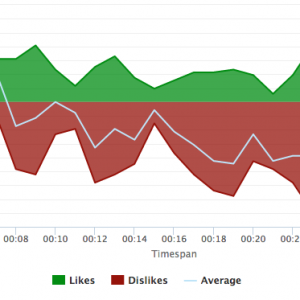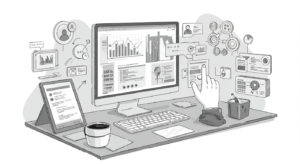Maximizing ROI with AI Ad Testing

Advertising has come a long way from its traditional roots. The advent of technology has revolutionized the field, and Artificial Intelligence (AI) is at the forefront of this evolution. In recent years, AI has been increasingly utilized to measure the effectiveness of advertising campaigns. AI-powered ad testing has made it possible for businesses to measure the effectiveness of their ads with utmost precision, and optimize their campaigns to maximize returns. In this article, we will explore the role of AI in ad testing, its benefits, and how to implement it in your marketing strategy to achieve maximum ROI.
Understanding the Importance of AI in Advertising
The shift from traditional advertising methods to digital marketing has been rapid. The increase in the availability and affordability of technology has also led to an increase in competition. To stay ahead of the competition, businesses must invest in ad testing as part of their marketing strategies. AI-powered ad testing technologies provide businesses with the necessary tools to test their ads and optimize their campaigns based on data-driven insights.
The Evolution of Advertising Technology
Advertising technology, or AdTech, has undergone a significant transformation over the years, from traditional formats such as billboards and newspapers to digital formats such as online ads and social media. With the advent of AI, businesses can now utilize data and analytics to personalize their ad campaigns and deliver more effective results. AI-powered ad testing programs enable businesses to test multiple variations of their ads and identify the most effective combination of elements to generate the most ROI.
As the advertising industry continues to evolve, businesses must keep up with the latest trends and technologies to remain competitive. AI-powered ad testing is one of the most effective ways to stay ahead of the curve and ensure that your advertising campaigns are optimized for success.
Benefits of AI-driven Ad Testing
One of the key benefits of AI-driven ad testing is that it provides businesses with a data-driven approach to advertising. Without the need for manual input, AI-powered programs can analyze vast amounts of data from ad campaigns, identify trends, and make predictions. This provides businesses with valuable insights that can help in determining the most ideal ad combinations to deploy.
AI-powered ad testing also enables businesses to test their ads in real-time, allowing for quick and efficient optimization. This approach can lead to significant improvements in campaign performance and ROI.
Furthermore, AI-based ad testing enables businesses to allocate their resources more efficiently. By identifying the most effective ad combinations, businesses can focus their resources on deploying those combinations that will generate the highest ROI. This approach can lead to significant cost savings and improved campaign performance.
How AI Enhances Traditional Ad Testing Method
Traditional ad testing methods typically rely on human input and feedback especially when it comes to the analysis. These methods can be subjective, and the results may not include all insights buried in the data. AI-powered ad testing programs, on the other hand, are objective and not influenced by human bias. They analyze vast amounts of data to produce accurate and actionable insights that can be leveraged for campaign optimization.
AI-powered ad testing also enables businesses to test their ads on a larger scale. With traditional ad testing methods, businesses may only be able to test a few variations of their ads due to time and resource constraints. AI-powered ad testing, however, can test hundreds or even thousands of ad variations in a matter of minutes, providing businesses with a much more comprehensive understanding of their ad performance.
In conclusion, AI-powered ad testing is a crucial tool for businesses looking to optimize their advertising campaigns and stay ahead of the competition. By leveraging the power of AI, businesses can gain valuable insights into their ad performance and make data-driven decisions that lead to improved ROI and campaign success.
Areas where AI has advanced ad-testing more recently range from the speed and quality of audience recruiting to more noticeably finding correlations in the data and helping market research experts craft the story behind the data faster. The technology will most likely advance to a place where the average person can gain reliable and accurate insights without the aid in human market researchers.
Implementing AI Ad Testing Strategies
Identifying Your Advertising Goals
Businesses must identify their advertising goals before implementing AI ad testing strategies. These goals typically include increasing brand awareness, generating leads, and driving sales. It is important to note that these goals may vary depending on the industry, target audience, and current market trends.
For instance, a business in the fashion industry may prioritize brand awareness through visually appealing ads that showcase their latest collection. On the other hand, a B2B company may focus on generating leads through informative ads that highlight the benefits of their services.
Once these goals have been identified, businesses can then determine the most effective ad combinations to achieve them. This involves testing various ad elements such as headlines, images, and calls to action to find the winning combination that resonates with the target audience.
Selecting the Right AI Ad Testing Tools
The success of AI-powered ad testing relies heavily on the tools used. Businesses must select the appropriate tools based on their advertising goals and budget. Key factors to consider include the algorithms used, the data inputs, and the results’ accuracy.
One popular AI ad testing tool is Google Ads’ Responsive Search Ads (RSA). RSA uses machine learning to test multiple combinations of headlines and descriptions to determine the best-performing ad.
Another tool for more specifically testing ads’ creative performance and optimizing messaging is Spot Trender’s ad testing platform which includes AI-powered technology throughout the entire research process. With new tools coming out all the time, increasing the effectiveness of ads is becoming more reliable through better insights.
Choosing the right tool is crucial for the success of the ad testing campaign. It is important to evaluate multiple tools and compare their features before making a decision.
Integrating AI Ad Testing into Your Marketing Workflow
The integration of AI-powered ad testing into the marketing workflow is essential. This involves identifying the points in the workflow where AI can be best applied, setting performance metrics, and tracking the results.
For instance, businesses can use AI to analyze their target audience and identify the best time to launch an ad campaign. They can also use AI to track user behavior and optimize real-time ad performance.
This comprehensive approach enables businesses to optimize their advertising campaigns and generate the most ROI. It also allows them to stay ahead of the competition by leveraging the power of AI to gain insights and make data-driven decisions.
Key AI Ad Testing Metrics and KPIs
Artificial Intelligence (AI) has revolutionized the way businesses approach advertising. With AI, businesses can test their ads in real-time, analyze the results, and optimize their campaigns for maximum effectiveness. However, to measure the success of an ad campaign, it is essential to track key metrics and KPIs. Here are some of the most important metrics to consider:
Click-Through Rates (CTR)
CTR is a vital metric in AI ad testing. It measures the number of clicks an ad receives compared to its impressions. High CTR rates indicate that an ad is resonating with the target audience and generating interest in the product or service being advertised. However, it’s important to note that a high CTR rate does not necessarily mean an ad generates sales. It only indicates that people are clicking on the ad.
For example, let’s say you’re running an ad campaign for a new line of sneakers. You notice that one of your ads has a high CTR rate, but low conversion rates. Upon further analysis, you discover that the ad is attracting people who are interested in the design of the sneakers, but not necessarily in buying them. With this information, you can optimize your ad campaign to target people more likely to purchase the sneakers.
Conversion Rates
Conversion rates measure the number of people who take a desired action, such as making a purchase, after viewing an ad. Conversion rates are essential metrics in measuring the effectiveness of an ad campaign, and can help businesses optimize their ads to generate more sales. However, it’s important to note that conversion rates can vary depending on the product or service being advertised, as well as the target audience.
For example, let’s say you’re running an ad campaign for a new line of organic skincare products. You notice that one of your ads has a low conversion rate. Upon further analysis, you discover that the ad attracts people interested in natural skincare but hesitant to purchase new products without trying them first. Armed with this information, you can create a new ad that offers a free sample to entice potential customers to try your products.
Return on Ad Spend (ROAS)
ROAS measures the revenue generated from an ad campaign compared to the amount spent on the campaign. This metric provides businesses with a clear indication of the profitability of their advertising campaigns. A high ROAS indicates that an ad campaign is generating more revenue than the cost of the campaign, while a low ROAS indicates that the campaign is not profitable.
For example, let’s say you’re running an ad campaign for a new line of fitness equipment. You notice that one of your ads has a high ROAS, indicating that the campaign is generating more revenue than the cost of the campaign. Upon further analysis, you discover that the ad is attracting people who are interested in purchasing the equipment for their home gym. Armed with this information, you can optimize your ad campaign to target people who are more likely to purchase the equipment.
Cost per Acquisition (CPA)
CPA measures the cost per new customer acquisition from an ad campaign. This metric enables businesses to allocate their advertising budgets more efficiently and optimize their ad campaigns to generate more customers at a lower cost per acquisition. A low CPA indicates that an ad campaign is generating new customers at a lower cost, while a high CPA indicates that the campaign is not generating new customers efficiently.
For example, let’s say you’re running an ad campaign for a new line of meal delivery services. You notice that one of your ads has a low CPA, indicating that the campaign is generating new customers at a lower cost. Upon further analysis, you discover that the ad is attracting people who are interested in healthy meal options but are too busy to cook. Armed with this information, you can optimize your ad campaign to target people who are more likely to use meal delivery services.
In conclusion, tracking key metrics and KPIs is essential for measuring the success of an AI ad campaign. By analyzing these metrics, businesses can optimize their ad campaigns to generate more sales, attract new customers, and increase profitability.
Creative Ad Testing Metrics
There are many metrics to consider when testing ads’ creative performance. These can include:
- Aided and Unaided Brand Awareness
- Purchase intent (pre and post viewing the ad)
- Likelihood to Act (share, visit, etc)
- Brand Recall
- Comprehension/Understand
- Music, Voice, Characters in the spots
- Memorable
Optimizing Your Ad Campaigns with AI Insights
Analyzing AI-generated Ad Performance Data
Analyzing AI-generated data is vital in identifying patterns and trends in ad performance. This enables businesses to optimize their ad campaigns and generate better ROI.
Identifying Patterns and Trends
Identifying patterns and trends in ad performance data can provide valuable insights into the most effective ad combinations, ad formats, and audience targeting strategies. This information can be leveraged to optimize ad campaigns and generate higher ROI.
Making Data-driven Decisions for Ad Optimization
Making data-driven decisions based on AI-generated insights is a critical aspect of optimizing ad campaigns. These data-driven decisions enable businesses to measure the effectiveness of campaigns based on accurate and actionable data, which can lead to improved campaign performance and more significant ROI.
Conclusion
AI-powered ad testing has revolutionized the way businesses measure the effectiveness of their advertising campaigns along with companies such as Spot Trender. From identifying the most effective ad combinations to optimizing campaigns for maximum ROI, AI has proven to be a valuable tool in the world of digital marketing. By integrating AI ad testing strategies into marketing workflows, businesses can leverage data-driven insights to generate better campaign results and stay ahead of the competition.








